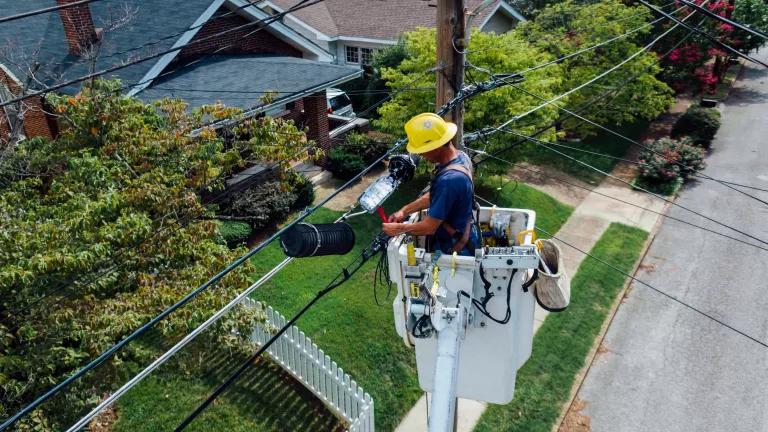Residential Energy Efficiency is Largest Source of CO2 Reduction Potential
In a little over a month, we’ve experienced three devastating hurricanes that have stretched the nation’s capacity to respond and recover. Meanwhile, tropical storm Nate is now forming in a gulf, expected to reach landfall as a hurricane somewhere between Louisiana and Florida adding further stress to people, communities and infrastructure still ill equipped to handle repeated storm threats.

*As the negative sign indicates, nuclear plant closures are not a driver of emissions reductions, but they have been included here for completeness.
This is part of a series of blogs on NRDC’s new report, “America’s Clean Energy Frontier: The Pathway to a Safer Climate Future”
In a little over a month, we’ve experienced three devastating hurricanes that have stretched the nation’s capacity to respond and recover. Meanwhile, tropical storm Nate is now forming in a gulf, expected to reach landfall as a hurricane somewhere between Louisiana and Florida adding further stress to people, communities and infrastructure still ill equipped to handle repeated storm threats.
The combination of increased intensity and frequency of heatwaves, droughts and hurricanes will all factor in increasing the cost of climate inaction, which hits low income families hardest. These disparities will visit low income families and communities of color due to the unique vulnerabilities to the direct effects of the extreme weather and by the uneven pace of recovery whereby actions to support these families are likely to be inadequate to meet the need.
As we observe the nation’s 2nd annual Energy Efficiency Day in the shadow of past and potential hurricanes, we are reminded of the critical role that energy efficiency can play in reducing the greenhouse gas emissions that are driving climate change and the threat to these communities from extreme weather.
A recent repot featuring comprehensive modeling by NRDC and Energy + Environmental Economics (E3) outlines a cost-effective pathway to reducing greenhouse gas emissions (GHG). The report offers an actionable blueprint for how GHG reductions can be achieved and provides a new, unique pathway by “combining more aggressive—but achievable—assumptions on the potential to scale up energy efficiency, renewable energy, and clean, efficient electrification, with complex energy system modeling tools that the most sophisticated Department of Energy and private sector analyses employ”.
Residential Energy Efficiency Leads the Way on CO2 Reduction
One of the major highlights of the report that the single largest source of CO2 equivalent emissions from a single intervention is residential energy efficiency. As the summary chart below shows, residential efficiency can account for as much as 550 million metric tons of CO2 equivalent emissions reductions annually by 2050 (equal to the combined electric power emissions of California, Texas, New York, Florida, Illinois, and Virginia in 2016). The next highest single intervention source is electrification of vehicles which would account for approximately 481 metric tons of CO2 equivalent emissions reductions annually.
The transportation sector offers the largest combined emissions reduction potential across multiple strategies but no other sector offers a higher potential for a single source of reduction than residential efficiency.
The results highlight the critical importance of residential efficiency to meeting our climate goals as a nation. However, even as we slowly begin to recognize the cost effective value of pursuing more energy efficiency, the provision of energy efficiency services to low income families continues to fall short of the need and potential. Struggling families sometimes spend more than 20 percent of their incomes on electricity and heat—far more than the national average of 2.7 percent.
When we invest in energy efficiency our whole society benefits. Boosting energy efficiency also means we avoid the cost of building out expensive energy infrastructure like power plants and transmission lines, reducing everyone’s energy related utility cost. And everyone’s health improves when we help stabilize the climate and reduce the amount of hazardous mercury, sulfur dioxide and particulate matter spewing out of power plant smokestacks and furnaces.
Ensuring the Multiple Benefits of Energy Efficiency Reach Everyone
In addition to the environment, health and cost saving benefits of investing in energy efficiency, there are job and economic development benefits that provide opportunities for families.
The clean energy economy is growing and it will only continue as it proves the most cost effective resource available and necessary to avoid dangerous levels of climate change. However, deliberate actions are required to ensure that the benefits of energy efficiency programs and services reach low income families.
Energy Efficiency for All is working to ensure that those investments reach low-income households. Key strategies to improve low income energy efficiency programs include,
- Improve and expand federal low-income home energy assistance, weatherization assistance and project based rental assistance programs;
- Improve and expand utility programs (including reforming utility cost/benefit testing to fairly value low-income efficiency potential);
- Collect, track, and report demographic data on program participation;
- Strengthen coordination across multiple policy levers programs.
To minimize costs, protect low income communities, safeguard public health, create jobs and lower the risk associated with extreme weather events like the hurricanes that continue to threaten our communities, low income efficiency programs are essential components of our pathway to a safer climate future.



